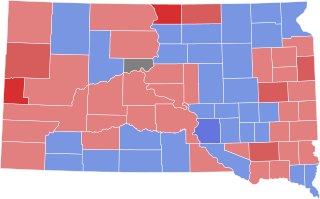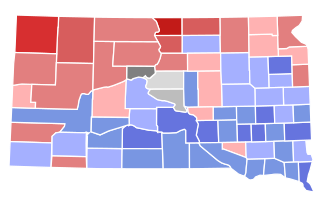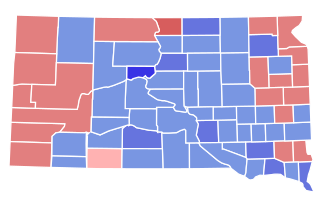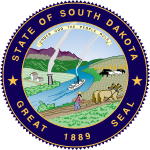
The 1948 United States Senate election in South Dakota took place on November 2, 1948. Incumbent Republican Senator Harlan J. Bushfield, suffering from poor health, declined to run for re-election. On September 27, 1948, he died in office; his wife, Vera C. Bushfield, was appointed to succeed him. Congressman Karl E. Mundt easily won the Republican primary and advanced to the general election, where he was opposed by Democratic nominee John A. Engel, an attorney. Hundt defeated Engel in a landslide.

The 1894 South Dakota gubernatorial election was held on November 6, 1894. Incumbent Republican Governor Charles H. Sheldon ran for re-election to a second term. Despite facing a thread of defeat at the Republican convention, Sheldon was renominated unanimously. In the general election, he faced Populist nominee Isaac Howe, a Spink County Judge; James A. Ward, the former state chairman of the South Dakota Democratic Party; and Prohibition nominee M. D. Alexander. The election was largely a replay of the gubernatorial elections of 1890 and 1892, with the Farmers' Alliance candidate placing second and the Democratic nominee placing a distant third. This time, however, Sheldon won an outright majority and the Democratic Party's vote share shrunk to just 11%, its worst performance in state history.

The 1900 South Dakota gubernatorial election was held on November 6, 1900. Incumbent Governor Andrew E. Lee, a Populist elected under Fusion with Populists, Free Silver Republicans, and Democrats, opted to run for Congress rather than for a third term. Former Sioux Falls Mayor Burre H. Lien won the Fusion nomination and ran against former Lieutenant Governor Charles N. Herreid. However, despite the closeness of the 1896 and 1898 elections, the Fusion's luck ran out; Herreid defeated Lien in a landslide to reclaim the office for the Republican Party.

The 2018 South Dakota gubernatorial election took place on November 6, 2018, to elect the next governor of South Dakota. Incumbent Republican governor Dennis Daugaard was term-limited and could not seek a third consecutive term.

The 1954 United States Senate election in South Dakota took place on November 2, 1954. Incumbent Republican Senator Karl E. Mundt ran for re-election to his second term. He was opposed by former State Representative Kenneth Holum, the Democratic nominee. Mundt defeated Holum in a landslide to win re-election.

The 1962 United States Senate election in South Dakota took place on November 6, 1962. Incumbent Republican Senator Francis H. Case ran for re-election to a third term. He won the Republican primary against Attorney General A. C. Miller, but shortly after the primary, died. The Republican State Central Committee named Lieutenant Governor Joseph H. Bottum as Case's replacement on the ballot, and Governor Archie Gubbrud appointed Bottum to fill the vacancy caused by Case's death. In the general election, Bottum was opposed by Democratic nominee George McGovern, the Director of Food for Peace and the former U.S. Congressman from South Dakota's 1st congressional district. The contest between Bottum and McGovern was quite close, with McGovern narrowly defeating him for election by just 597 votes, making him the first Democrat to win a Senate election in South Dakota since William J. Bulow's win in 1936.

The 1910 South Dakota gubernatorial election was held on November 8, 1910. Incumbent Republican Governor Robert S. Vessey ran for re-election to a second term. He faced two serious competitors in the Republican primary: colorful disbarred attorney George W. Egan and former Governor Samuel H. Elrod, and won the primary only with a narrow plurality. In the general election, he faced Democratic nominee Chauncey L. Wood, the Mayor of Rapid City. He improved on his margin from 1908, defeating Wood in a landslide.

The 1912 South Dakota gubernatorial election was held on November 5, 1912. Incumbent Republican Governor Robert S. Vessey declined to run for re-election to a third term. Lieutenant Governor Frank M. Byrne won the Republican primary to succeed Vessey, and then faced State Senator Edwin S. Johnson, the Democratic nominee, in the general election. Byrne only narrowly defeated Johnson, winning just 49% of the vote to Johnson's 46%, the closest gubernatorial election since 1898.

The 1950 South Dakota gubernatorial election was held on November 7, 1950. Incumbent Republican Governor George T. Mickelson was unable to seek re-election to a third term due to newly imposed term limits. Accordingly, a competitive race to replace him ensued. Attorney General Sigurd Anderson won a slim plurality in the Republican primary, barely exceeding 35% and narrowly avoiding having the Republican nomination sent to the state party convention. In the general election, Anderson faced State Representative Joe Robbie. Anderson easily defeated Robbie, winning his first term with 61% of the vote to Robbie's 39%.

The 1946 South Dakota gubernatorial election was held on November 5, 1946. Incumbent Republican Governor Merrell Q. Sharpe ran for re-election to a third term, but was defeated in the Republican primary by Attorney General George T. Mickelson. In the general election, Mickelson faced farmer Richard Haeder, the Democratic nominee. In part because of South Dakota's growing trend toward the Republican Party, and because of the national Republican landslide, Mickelson easily defeated Haeder, winning 67% of the vote to Haeder's 33%.

The 1944 South Dakota gubernatorial election was held on November 7, 1944. Incumbent Republican Governor Merrell Q. Sharpe ran for re-election to a second term. He was opposed Lynn Fellows, a former State Representative from Aurora County the 1942 Democratic nominee for Attorney General, in the general election; both Sharpe and Fellows won their primaries unopposed. In the general election, Sharpe easily defeated Fellows, far outpacing even Republican presidential nominee Thomas E. Dewey, who won the state in a landslide.

The 1938 United States Senate elections in South Dakota took place on November 8, 1938. Incumbent Republican Senator Peter Norbeck died in office on December 20, 1936. Herbert E. Hitchcock was appointed by Governor Tom Berry as Norbeck's replacement. Two elections for the same Senate seat were held on the same day; one as a special election to fill the remainder of Norbeck's six-year term, and another to select a Senator to serve the next six-year term.

The 1924 South Dakota gubernatorial election was held on November 4, 1924. Incumbent Republican Governor William H. McMaster declined to run for re-election to a third term, instead opting to run for the U.S. Senate. Lieutenant Governor Carl Gunderson won the Republican primary unopposed. In the general election, he faced three prominent opponents: Democratic nominee William J. Bulow, a former State Senator and Mayor of Beresford; Farmer–Labor nominee A. L. Putnam; and perennial candidate Richard O. Richards. Gunderson. With the left-leaning vote split, Gunderson won the election in a landslide.

The 1926 South Dakota gubernatorial election was held on November 2, 1926. Incumbent Republican Governor Carl Gunderson ran for re-election to a second term. The election was largely a rematch of the 1924 election, with Gunderson's chief opponent from two years prior, Democrat William J. Bulow, challenging him once again. Two other candidates—Farmer–Labor nominee Tom Ayres and Pierre Mayor John E. Hipple, an independent—also ran. Though the left-leaning vote was split, Bulow was still able to win a decisive victory over Gunderson, whose support from two years earlier had completely collapsed.

The 1928 South Dakota gubernatorial election was held on November 6, 1928. Incumbent Democratic Governor William J. Bulow ran for re-election to a second term. In the general election, he faced Attorney General Buell F. Jones, the Republican nominee. Despite Republican presidential nominee Herbert Hoover overwhelmingly defeating Democratic nominee Al Smith overwhelmingly in South Dakota, Bulow defeated Jones by a decisive margin to retain the governorship. In so doing, he became the first Democratic candidate for Governor to receive a majority of the vote in the state's history.

The 1930 South Dakota gubernatorial election was held on November 4, 1930. Incumbent Democratic Governor William J. Bulow declined to run for re-election to a third term, instead opting to successfully run for the U.S. Senate. The Republican nomination was hard-fought and the primary was crowded; because no candidate received 35% of the vote, state law required that the nomination be decided at a state party convention. There, former State Senator Warren Green, the last-place finisher in the primary, defeated Secretary of State Gladys Pyle, the plurality winner. In the general election, Green faced D. A. McCullough, the state's Rural Credits Commissioner and the Democratic nominee. Despite Bulow's success in the preceding two elections, Green defeated McCullough by a decisive margin—even as Bulow himself was elected to the U.S. Senate.

The 1932 South Dakota gubernatorial election was held on November 8, 1932. Incumbent Republican Governor Warren Green ran for re-election to a second term. He defeated former Governor Carl Gunderson in the Republican primary and faced former State Representative Tom Berry, the Democratic nominee, in the general election. Aided by Democratic presidential nominee Franklin D. Roosevelt's landslide victory in South Dakota, Berry defeated Green for re-election in a landslide.

The 1936 South Dakota gubernatorial election was held on November 3, 1936. Incumbent Democratic Governor Tom Berry ran for re-election to a third term, the first Governor of South Dakota to do so. Berry was challenged by Republican Leslie Jensen, the former Collector of Internal Revenue for the state of South Dakota. Both Berry and Jensen won their primaries uncontested and advanced to the general election. Some drama surrounded the potential candidacy of Democratic State Auditor George O'Neill as an independent candidate for Governor or, in the alternative, his cross-party endorsement of Jensen; after initially announcing his campaign and hedging, O'Neill dropped out of the race in September and endorsed the Democratic ticket in the state, including Berry.

The 1940 South Dakota gubernatorial election was held on November 5, 1940. Incumbent Republican Governor Harlan J. Bushfield sought re-election to a second term. After winning the Republican primary by a large margin, he faced Democrat Lewis W. Bicknell, former Day County State's Attorney, in the general election. Though Bushfield underperformed Republican presidential nominee Wendell Willkie, who won the state in a landslide, he nonetheless defeated Bicknell by a wide margin to easily win re-election.

The 1942 South Dakota gubernatorial election was held on November 3, 1942. Incumbent Republican Governor Harlan J. Bushfield declined to seek re-election to a third term and instead successfully ran for the U.S. Senate. A crowded Republican primary developed to succeed him, and because no candidate received 35% of the vote, the nomination was decided at the state Republican convention, where former Attorney General Merrell Q. Sharpe, the second-place finisher in the primary, won the nomination. In the general election, Sharpe faced Democratic nominee Lewis W. Bicknell, the 1940 Democratic nominee for Governor. Aided by the national Republican landslide, Sharpe defeated Bicknell in a landslide.






















